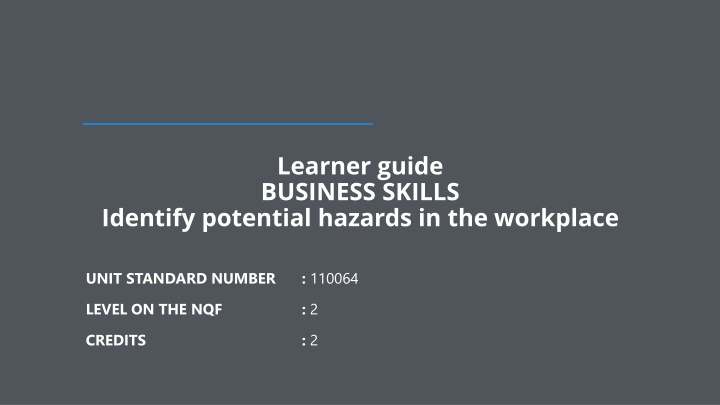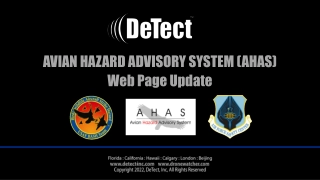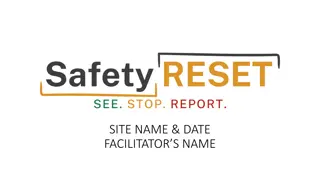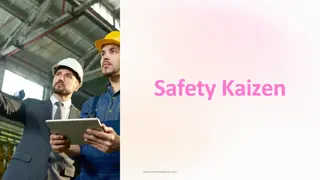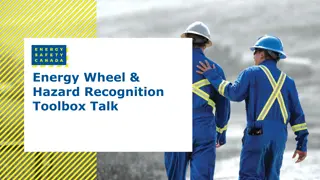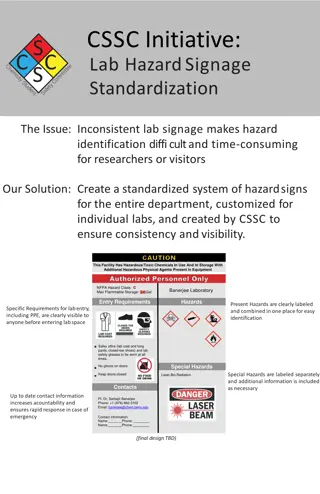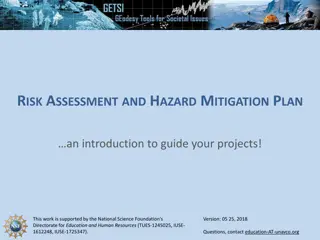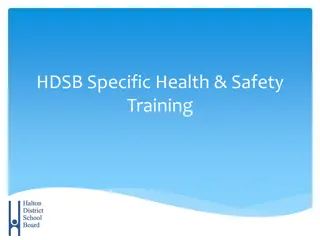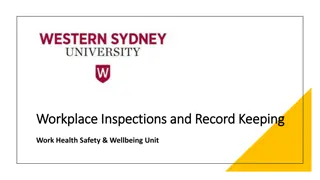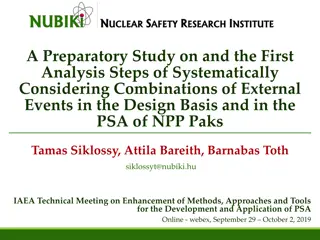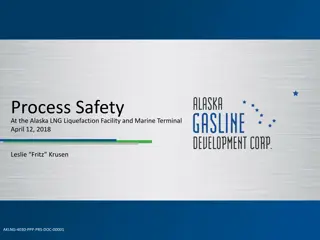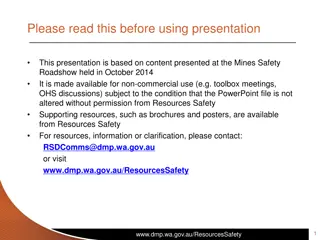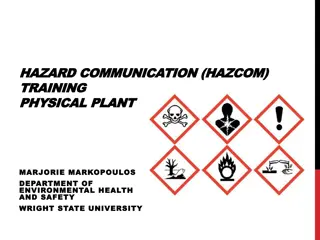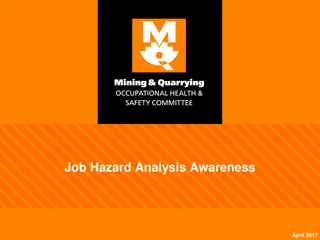Workplace Hazard Identification and Safety Procedures
UNIT STANDARD: 110064 - This unit standard focuses on identifying potential hazards in the workplace and following health, safety, and security procedures to ensure a safe environment. It is designed for individuals involved in administration in various organizations.
Download Presentation

Please find below an Image/Link to download the presentation.
The content on the website is provided AS IS for your information and personal use only. It may not be sold, licensed, or shared on other websites without obtaining consent from the author.If you encounter any issues during the download, it is possible that the publisher has removed the file from their server.
You are allowed to download the files provided on this website for personal or commercial use, subject to the condition that they are used lawfully. All files are the property of their respective owners.
The content on the website is provided AS IS for your information and personal use only. It may not be sold, licensed, or shared on other websites without obtaining consent from the author.
E N D
Presentation Transcript
Learner guide BUSINESS SKILLS Identify potential hazards in the workplace UNIT STANDARD NUMBER : 110064 LEVEL ON THE NQF : 2 CREDITS : 2
PURPOSE: This Unit Standard is intended for all people who are involved in, or who intend to be involved in administration in commercial and/or non-commercial organisations. Competence against this standard will add value to the learner`s job, or chances of finding employment. The qualifying learner is capable of: Demonstrating an understanding of standards and procedures governing health, safety and security in the workplace. Contributing to a safe and secure work environment.
SESSION 1. Identify potential hazards in the workplace Potential hazards are correctly identified and removed, reduced or reported in terms of own level of authority/capacity. Instructions relating to exposure to dangerous substances and hazards in the workplace are known and an explanation is given as to why they pose a potential threat to the work environment. The kinds of work that require protective clothing are identified and protective clothing is used according to legal requirements. Health and safety instructions are followed in situations that require lifting and handling of materials. The importance of each employee being vigilant and reporting hazards and violations of health, safety and security procedures is known and understood with reference to a possible chain of events that could result from not reporting a violation.
Introduction The Need for Safety, Health and Environmental Protection Early Days Since the existence of man, he has used natural objects as tools to assist him in performing tasks he alone was not capable of doing e.g. a stone to crush a hard seed or a branch of a tree to dislodge a large rock. This practice allowed man to do much more in a much shorter period of time. At the same time, however, man also discovered that working with these tools could cause injury and even death. Some practices caused disease due to the material that was handled or the environment where the work was undertaken. In his book River God , Wilbur Smith describes the activities of sculptors working inside a burial tomb. Many of them died as result of the clogging of their lungs, due to dust inhalation. This phenomenon was attributed to the intervention of the gods, as it could not be understood or explained.
Being the resourceful being he is, man quickly learned how to minimise or avoid injury and fatalities by devising methods for using tools more safely under safer conditions. This can be seen as the beginning of basic health- and safety management. The invention of the wheel made man mobile and new tools and operating procedures were developed to cope with the demand created by new inventions and the use thereof. For centuries man slowly developed new tools and machines, enabling him to achieve even more than what was ever possible. In the process he used existing tools to make and develop new ones. Certain trades were established and standards were set to promote uniformity. Safe practices became standard practices. In society the introduction of innovations such as running water on tap and (for the time) hygienic ablution facilities contributed substantially to the health and prosperity of man in general.
Accidents in The Workplace An Accident is an undesired event caused by unsafe acts or unsafe conditions that cause physical harm or has the potential for harm or the potential for loss. Causes of Accidents The three contributing factors that result in accidents are as follows. Unsafe acts 88% Unsafe conditions 10% Acts of providence 2% 98 % of all accidents can be prevented due to the causes of these accidents are things people do wrong in the work place. 2 000 000 Accidents were investigated and it was found that for every one major accident that caused death or disablement there can be 10 accidents that only caused minor injuries where only First Aid treatment was required, and 30 accidents that caused property damage.
Identify Potential Hazards There are various substances in the workplace which could harm the physical and possibly the mental health of workers. For example, toxic waste can be just as deadly as an unguarded machine mechanism, or over-exposure to poisonous gases or radiation can kill just as surely as a treacherous fall. The types of hazards which could be detrimental to the health of workers are mentioned in this lesson. These health hazards can be combated or reduced by wearing appropriate protective clothing and/or equipment. Some protective clothing is washable and can be re-worn, while other clothing is disposable. It is even possible to apply protective ointments and creams (barrier creams) to the body, and after the job has been completed, to simply wash off these creams. Workers must realise the importance of their health and safety, and must be diligent in wearing the appropriate protective clothing and/or equipment. Unsafe acts and conditions also lead to potential hazards in the workplace.
Unsafe acts and conditions An unsafe act is that which is done, or not done by people, causing injury, disease or damage to property, e.g. operating a dangerous machine or equipment while under the influence of alcohol. An unsafe condition, on the other hand normally exists where safety procedures have been neglected, e. g. the safety covers of a machine is removed. We encounter unsafe conditions and unsafe acts every day in our normal lives, even at home. Driving through an area where hijackings are common, constitute and unsafe act and an unsafe condition. The unsafe condition is the area where hijackings are common, while the unsafe act is to drive through that area. Avoid these areas if you can. Lighting a cigarette near explosive materials also constitutes an unsafe act and an unsafe condition the explosive materials are an unsafe condition and lighting the cigarette is an unsafe act. A river that is in flood is an unsafe condition, while trying to cross the river while it is in flood is an unsafe act. A heated stove plate is an unsafe condition, while putting your hand on the heated plate is an unsafe act.
Four basic reasons for unsafe Improper attitudes of the workers; Lack of knowledge or skills; Physical unsuitability; and Improper mechanical or physical environment. Except for reflex actions, unsafe acts are learnt acts, and can be replaced with learnt safe acts. If an employee's learning has been inadequate or misdirected, it is necessary to retrain an employee in the safe way. Many employees suffer injury because they are unschooled in safe behaviour, i.e., because there is a lack of knowledge of safety rules and procedures, or a lack of skill in the safe execution of job tasks.
Safe patterns of behaviour must become second nature to employees, so there should be a culture of continual learning in the organisation. This will eventually make safe acts automatic. Some employees commit unsafe acts to satisfy certain needs, and therefore an employee will try to get away with an unsafe act by using one of his own tricks of the trade. In this case the employee is trying to satisfy an emotional or psychological need. To correct this behaviour will take more than retraining the employee. When an employee becomes frustrated in the workplace this could result in irrational acts, often of an aggressive nature, which expose other employees to possible injury. Some frustration may also arise from off-the-job conditions, such as domestic circumstances. These frustrations are beyond the supervisor's control, although they too can lead to unsafe acts. Another cause of unsafe acts is the employee's preoccupation with matters that have nothing to do with his work, for example financial worries can cause undue stress. To summarise, the causes of unsafe acts could be: Lack of knowledge and inadequate skills as discussed above 1. Motivational factors 2. Difficulties of inattention 3. Perceptual difficulties
Temporary Periods of Stress Whatever their ages, all employees are at times subject to temporary periods of unusual stress If accidents are to be prevented in such periods of tension, it is necessary to assist employees to cope with their times of travail, at least to the extent of providing safeguards and helping with solutions which are within the supervisor's control. Effect of Personal Problems Inattention could in many instances be attributed to personal difficulties such as domestic circumstances which cannot be shed by employees as they daily enter the work-place. It could be helpful if the supervisor became a good listener during these periods, although it is undesirable for the supervisor to become intimately involved with the personal life of the employee. If an employee is enabled to talk out a problem with a sympathetic and understanding listener, he or she could see it in a different and more constructive light.
Effect of Job-related Conditions Sometimes a number of accident ingredients are present which are beyond the control of the employee. These pre- existing conditions could be hazardous. The employees may be unaware of these hazards, and their reaction to the situation, if they become aware, may be trial-and-error. If their response does not work, emotions may be aroused. The momentarily blind act or emotional act is often an unsafe act. The continuance of adverse job conditions can have an ominous and frustrating influence on employee conduct. This frustration may manifest itself in aggression, rigidity and childishness. These frustrations could also manifest themselves through unsafe acts. Distractions related to Work-place Location and Job Monotony Work-place locations can lead to unsafe acts if they subject the employee to competing demands, e.g., where workstations are near the toilets or a cafeteria. Monotony can also be troublesome as it often results in self-induced distractions. Supervisors should be on the lookout for any form of distraction.
Communication the Key to Inattention The supervisor should communicate meaningfully with the employee. Sometimes the source of frustration can be rectified by the supervisor. The supervisor must try to pinpoint the problem clearly. Sometimes the difficulty may have to be resolved jointly by the supervisor and the subordinate. At other times, the problem MUST be resolved unilaterally by either the employee or the supervisor. Perceptual difficulties It could happen that the reason for an unsafe act is as a result of perceptual failure. Perception means the ability to see, hear or become aware of something through the senses. It is also a way of understanding something. Perceptual failure means that the worker sees, hears or understands the facts wrongly. This can happen because the worker has been bombarded with too much information at one time. There are too many signals reaching the worker and this causes a wrong response or a late response. Because of a lack of perception, the worker can react in an uninformed or emotional manner; the worker could also react to a compelling signal without awareness of counter-indications
Interaction Click the Interaction button to edit this object
Types of Hazards Encountered in the Workplace The OHS Act defines a hazardas a source of or exposure to danger and a riskas the probability that injury or damage will occur. Each hazard thus has risk(s) involved. If you don t disconnect the electricity supply before working on an electrical appliance you run the risk of being electrocuted. The degree of risk involved varies according to the situation. When using a sharp knife to peel an apple, a two-year- old toddler will run a much greater risk of cutting himself than an adult performing the same exercise. Safe, according to the OHS Act means free from any hazard . Hazards will differ from work place to work place, and they could be the following, depending on the circumstances. For better understanding we will group hazards as follows: Physical Hazards These hazards can harm the body and/or influence or stop the effective functioning thereof.
Interaction Click the Interaction button to edit this object
Ergonomic Hazards These hazards relate to how worker friendly the worker s working environment is. Working under unfavorable conditions can cause discomfort and injury. Factors like having to stand for long periods, working in cramped spaces, not having adequate ventilation, etc. can all cause discomfort and eventual injury. The hazard is present in the working condition and the risk is the injury that could happen as a result of the hazard. Illumination Illumination is also an ergonomic hazard. For example, employers should attend to burnt out globes; defective fluorescent tubes; light fixtures covered with dirt, grease, or oil; little or no provision for emergency lighting; unlighted or dimly lit exits; Temporary lighting that has become permanent through oversight; and poorly-placed lighting sources that cast shadows in the employee's work areas.
Psychosocial Hazards This normally goes hand in hand with stress and tension in the workplace. A disgruntled worker might be so upset that it affects his ability to concentrate properly. If he works with dangerous machinery or equipment his lack of concentration may cause him to overlook safety precautions, resulting in injury or damage to property. working with machinery is hazardous and the risk is injury or damage to property if the machine is not operated safely. Hazardous substances "Substance" includes any solid, liquid, vapor, gas or aerosol, or combination thereof. Examples are inorganic materials such as lead, mercury, arsenic, cadmium, and asbestos and organic substances such as polychlorinated biphenyls (PCBs), vinyl chloride, and the pesticide DDT, benzene
Protective Clothing Personal Protective Equipment or PPE is the primary control measure to personal safety. When using Personal Protective Equipment, the hazards are still present in the environment. The protective device merely provides a barrier between the hazard and the worker. It is imperative to understand that the issuing of Personal Protective Equipment is the last resort when all other methods fail to render the hazard safe. The personal protective equipment supplied to you by your employer is for your personal safety and should be used by you only. This PPE remains the property of the COMPANY and should you misuse or abuse any safety equipment, action will be taken against you. It is the responsibility of the workers to look after the safety equipment provided and to use it where required to by safety signs, and management ruling. It is your responsibility to report any defects of your safety equipment to your supervisor immediately. When entering the client s premises, boards indicating the required PPE/PPC are displayed to inform people entering the site what to wear.
Reasons why protective equipment and clothing is not worn The equipment cannot be worn comfortably and with ease. The protective equipment interferes with normal working procedures. The worker does not understand (ignorant) the necessity of wearing the equipment and clothing; There has not been proper training and induction of the worker to his work environment. The worker is not penalised or disciplined for not wearing the equipment.
Requirements for protective clothing and equipment As far as personal protective clothing and equipment are concerned, the worker must be able to wear the equipment with ease and comfort; the protective clothing or equipment must not interfere with his normal working procedures; the necessity for wearing protective clothing/equipment must be brought home to the worker; and economic and other disciplinary action must be used to coerce the worker to constantly use protective clothing and equipment. The problem encountered with protective clothing and equipment is the fact that- these measures do not' eradicate the danger out of mechanical hazards of machinery - these hazards have to be designed out of machinery; the correct choice of equipment is not always easy; and getting workers accustomed to protective gear is sometimes difficult.
Types of physical protective equipment available Besides respirators and masks to filter out dust and fumes, and goggles and shields to guard the eyes, the following protective equipment is available: Protective hard hats/caps and women's nets; Aprons, Suits and jackets; Ear muffs; Visors and face shields; Welding helmets; Boiler suits; Dust-coats;
Protective garments can be made of plastic, leather, asbestos, artificial fibres and so forth, depending on what type of protection is desired. The aim of using protective clothing and equipment is to protect the human body and all its senses, e.g., hearing, seeing and smelling, from harm. Workers who do not wear goggles or ear muffs could lose their sight or sense of hearing. Workers should also be protected from the stealthy killers such as asbestos dust, imperceptible gases, e.g. LPG or liquefied petroleum gases, and mercury poisoning. Gases and other harmful substances should be correctly stored in properly marked containers. Employers should always monitor the levels of poisonous gases and other dangerous substances in their factories. Because every injury on duty has financial implications for both the employer and the employee, it is essential that injuries should be reduced to the absolute minimum. Workmen who are injured on duty can claim for compensation in terms of the WORKMEN'S COMPENSATION ACT, 1941 (Act 30 of 1941). No compensation is paid if the workman is guilty of serious and willful misconduct, unless the accident causes serious disablement or the workman dies. If the accident leads to serious disablement or death, the Commissioner will pay compensation even if the workman contravened the law or his employer's instructions, or acted without instructions, but only if he was injured while engaged in his employer's business. Should the workman be killed, his dependents are entitled to compensation.
Head Protection Hard hats provide protection for the head in areas where the danger of falling or flying objects exists, or where the head could be bumped against low structures. However, this protection could also be lost when a hard hat is cracked or the insert is damaged or missing. Hard hats must never be used as a seat or a bucket or for any other purpose except that for which they were designed. Hardhat linings must be washed when dirty and at least on a monthly basis
Hearing Protection Earplugs and earmuffs provide protection for the ears in noisy, hazardous areas, to prevent loss of hearing. Ear protectors must be maintained in an efficient and sanitary condition at all times. They should be stored in clean, dust-free containers; otherwise, users could suffer from infection of the ears. Eye and Face Protection Different situations will require different safety equipment. It is important that the most effective eye protection be worn and that the care must be taken when storing and cleaning this safety equipment as the lenses can scratch and thus causing a reduction in sight. Store this equipment in such a way that the lenses will not scratch. Safety spectacles provide protection for the eyes and must be worn where the danger of flying particles exists, e.g. where metal hand tools are used, such as chisels.
Full-face shields must be worn when grinding work is done, and where splashing hazards exist. Safety gogglesmust be worn in all dusty areas. All employees involved in flame cutting, welding or brazing operations must wear welding goggles. Hand Protection Safety gloves provide protection for the hands and must be worn if there is a chance that employees could suffer injuries to the hands, e.g. cuts or severe abrasions. Safety gloves must be kept clean and in a good condition and must never be neglected and left to lie around haphazardly.
Breathing Protection There are two kinds of protection available Filter type These respirators have filters, cartridges, or canisters that remove contaminants from the air by passing the ambient air through the air-purifying element before it reaches the user. These filters have a limited life span an have to be replace at regular intervals.
Air supplied type These supply clean air directly to the user from a source other than the air surrounding the user. The clean air is supplied by means of an air hose and this hose will have to be attached to the worker. Care must be taken as not to damage the air hose . Some of these filter type respirators can only be worn once or have a limited effective lifetime, and are to be changed when the user feel that little protection is offered. Respirators must be stored in such a manner that they will not be damaged and exposed to any substance. It is important to clean and inspect the respirator after it has been used. Before using a respirator, make sure that the respirator will offer the required protection and that all the parts are in a good working condition
Foot Protection Safety shoes are fitted with steel toecaps and provide protection to the feet against falling objects. Safety shoes and lasses must be kept in a good condition (cleaned and polished regularly) and must never be neglected. Protective Clothing Overalls are issued to employees to reduce the possibility of injury caused by contact or radiated heat, cold, abrasive or sharp surfaces. Loose, tattered clothing worn by employees is not only indicative of an untidy method of working, but is also a hazard as it is likely to get caught in moving machine parts.
Safety Harness Safety belts, harness, lifelines, and climbing shoes are essential to protect employees carrying out hazardous work above ground level. These items must be kept in an excellent state of repair and maintenance must be done under strict supervision. This equipment must be stored as per the equipment manufacturer s instructions. Important information about PPE Wear your personal protective equipment and clothing, you have everything to gain! Remember that these items are expensive and in order to gain maximum protection from them, one must treat them with respect. The PPE will only be effective if it is used correctly and for the purpose that it was designed for. You must report defective equipment of ineffective PPE to your supervisor or Health and Safety Representative immediately. Using damaged or ineffective PPE will damage your health and will lead to other injuries
Prevent accidents through proper housekeeping Proper place for everything In the plant or factory, it is essential that everything has its proper place, i.e., the factory must be orderly and tidy so that there is no need to search for tools; so that space is saved; so that fire hazards are reduced; and so that injuries are avoided. If there is poor housekeeping, the incidence of accidents is bound to increase, e.g., tripping over loose objects; articles dropping from above or on a worker's head; slipping on greasy and dirty floors; staff running into protruding materials and objects; hands and other bodily parts being injured on projecting items such as nails; and fires.
Definition of housekeeping: A place for everything and everything in its place. Good lighting. Good ventilation Hygiene facilities to be kept clean All aisles and storage areas clearly marked Good stacking and storage practices Stacked goods must not endanger life Factory yards must be kept tidy All refuse to be placed in bins
Remember the definition of housekeeping; the following steps should be practiced in the housekeeping concept. Passages, aisles and walkways should be marked and kept clear of obstacles to prevent workers and visitors from injuries. Waste bins should be provided. If there is no waste bins workers tend to through waste materials and papers on the floor, this will create a fire hazard in the work place. All spillages must be cleared and cleaned immediately to prevent workers to slip, or be contaminated if chemicals are involved. Report any unusual parcels or packages to security Place everything in the correct place and store all products correctly. Clean up your work place at the end of every shift. (Do not leave it for the follow-up shift to clean.
Benefits of good housekeeping The effect of good housekeeping on staff is that it improves both the working environment and morale of the workforce. This means more pleasant working conditions which will in the long-term increase efficiency, ineffectiveness and economy. The main benefits of good housekeeping are as follows: Reduced operating costs Improved production control Production time is saved; Traffic flow is facilitated; There is higher employee morale Increased production materials and parts are conserved
How to Work Safely In order to help you with inspections and also to be able to develop an inspection check list, we will take a look at what has to be done in order to work safely. Never: Enter a work area that you have not been authorised to enter. Operate any equipment that you have not been trained to operate Always Wear: suitable protective clothing safety boots hard hats overalls
Use Gloves, Aprons Other Special Clothing When Handling: rough materials chemicals hot or cold objects. Wear hearing protection whenever notices indicate that you are in an area that requires you to wear hearing protection. Wear Respirators When: spray painting welding and cutting the area is very dusty there is any other toxic danger in other areas where it is required
Get To Know Your Work Place, In Particular: warning and prohibitor signs location of firefighting appliances your safety representative and first-aider emergency exits. Be Aware Of Other Work Near You. In particular: do not walk under suspended loads and be aware of persons working above you watch out for vehicles mobile equipment.
First Aid & Occupational Hygiene Every workplace, however small, is equipped with a First Aid Box. First Aid Boxes will be allocated to certified first-aiders. Every injury must be treated and reported to the person in charge. Injuries, which require professional medical treatment, an appropriate accident report form has to be made out immediately by the person in charge and the injured person taken to the site clinic. First Aid Boxes must be kept properly stocked with the minimum required contents. or when the room in which they are installed is unoccupied. Manholes Work in manholes is governed by rules of work conducted in confined spaces. Dangerous Places All open holes, as well as open sides of buildings must be made safe by respectively boarding over and / or by barricading to prevent people from falling to another level. Barricading All minor and excavations must be barricaded by means of solid barricading. Barrier (chevron) tape will be allowed as a means of demarcation only.
Motor Vehicles Only authorized persons may drive Company vehicles. The driver must have the appropriate license for the vehicle he is driving. If involved in any accident onsite / off site resulting into damages to the vehicle, the Responsible Person must be notified and required accident report form completed. Transporting Personnel / Material No person is allowed to be transported on the loading platform of a truck or LDV unless the following conditions are met: The driver of any vehicle must ensure that before reversing his vehicle there are no people in his path or if so, they are aware of his vehicle s movements at all times. All construction vehicles, and mobile equipment shall be fitted with a reverse alarm/hooter.
Special precautions Special care must be taken with substances such as liquids and chemicals, and also with tools and equipment, particularly explosive powered tools. Guidance should be sought from the manufacturers about the handling of hazards associated with the storage of oils, reagents, acids, flammable and toxic substances. The three commonly used mineral acids; nitric, hydrochloric and Sulphur are explosive under certain circumstances and require careful handling and storage. Powerful oxidizing agents such as chlorates, nitrates and peroxides can also become explosive when they are mixed or come into contact with organic matter such as starch, gum and resin. Sodium peroxide will heat up in the presence of moisture, and all of these substances will release oxygen if sufficiently heated, thus enhancing the danger of fire. Racks and holders suited to the size of tools and equipment should be provided. Explosive powered tools and cartridges must be stored in a safe place to ensure that they are inaccessible to unauthorised persons.
Other precautionary measures Colour Coding for Safety Identification It is usual practice in the factory setup to colour code some hazardous areas, machinery or dangerous substances, e.g. the colour RED usually indicates danger; fire protection equipment or stop buttons and emergency stop controls; YELLOW usually indicates caution; and warnings of hazards from radio-activity; GREEN indicates the location of first aid facilities; location of gas masks; exit signs other than emergency signs; safe areas; parking areas; equipment storage; safety instruction; toilets; offices and entrances; light ORANGE is used on the inside surfaces of machine guards as well as the dangerous parts of a machine capable of cutting, shearing or crushing; the surfaces of protruding shafts, the faces of gear wheels and any rotating part of a machine.
Factory Layout It is essential that the factory layout and premises in general are maintained in a good condition. This will minimize the risk of accidents. Faulty design or maintenance of premises, obstruction of access routes and traffic aisles should be prevented. Floors should not be overcrowded/overloaded. Floor and wall openings, staircase wells, passenger and goods lift cages, gangways and overhead platforms should all be suitably fenced. Guard rails should be of adequate dimensions and strength, and toe-boards should be fitted on gangways passing over areas where people are working and where there is a danger of falling objects. Suitable means of access to machinery and equipment should be provided so that maintenance teams are not required to perform dangerous or acrobatic maneuvers in their regular work. Crush, nip or shear points between moving and stationary objects should be eliminated or guarded. Emergency exits to ensure a means of escape in the event of fire should be sufficient in number, correctly positioned and signposted, and free from encumbrance. Good lighting is essential for the safe movement of persons, plant and equipment. Inadequate lighting levels may conceal obstacles or danger zones, whereas badly positioned or excessively powerful light sources nay cause glare.
Classes and types of machine guards There are two classes of machine guards, namely, transmission guards and point of operation guards. There are three types of guards, namely: Fixed Guards - these do not move with each operation; Interlocking Guards - these guards prevent the controls of the machine from being used until the guard is moved into place; and Automatic Guards - these prevent the machine operator from coming into contact with the dangerous parts of a machine while it is moving. Requirements of machine guards Machine guards should comply with the following requirements: They should afford the maximum protection possible; The danger zone(s) should be blocked out during operation;
Moving machinery Maintenance and adjustments should never be carried out on machinery that is running or moving. Machinery must be stopped and "locked out" before any repair or maintenance work is carried out. "Locked Out" means that any electricity, steam, air pressure or anything else that drives the machine is disconnected or isolated so that the machine being worked upon, cannot be accidentally started and so injure the person carrying out the work. Maintenance of mechanical equipment Mechanical equipment must be maintained and kept in good order to ensure efficient and smooth operation. Poorly maintained machinery will produce poor quality, place greater strain on the machine, the material and the operator and lead to early failure. Cutting edges must be kept sharp. Moving parts must be well lubricated. Air filters must be kept clean. Loose parts must be fixed properly with bolts and nuts and not tied with wire
Inspections or repairs on machinery NO One is allowed to repair, adjust, clean or oil moving machinery unless such is done by a competent person, and only when it is impractical to stop such machinery. Automatic oiling devices should be installed as far as possible/practicable. The operator of any machinery must be trained to inspect the machinery that he intends using daily before use. Company Vehicles Company vehicles should be checked regularly for Faulty brakes; Faulty headlights; Damaged connecting cables; General lighting; Worn tyres; Faulty windscreen wipers
Fire hazards Fire hazards exist in processes or operations that use flame producing equipment such as welding and cutting equipment, gas torches and blow lamps. A few precautions are necessary before and after using this equipment: Before beginning work, check that there is no combustible (materials that burn easily) materials in the work area. Clear away any rubbish or litter and make sure timbers (wood) lying nearby and anything else which cannot be removed that might catch fire is protected from heat and flame. This can be done by shielding it with non- flammable material. Keep a suitable fire extinguisher at hand at all times. Remember that metal work (such as pipes and conduits) can conduct heat to consumable materials such as floor and ceiling joists. It is very important to make a further check when the job is done to ensure that nothing has been left smouldering.
Electrical safety measures Burns from electrical apparatus Besides electric shock, electricity can also cause external burning, e.g. the arc of a welding machine produces temperatures between 6 0000 to 8 0000 centigrade. Persons standing nearby such an arc will be severely burnt and such an arc may start a fire by igniting flammable material. When the arc resulting from a breakdown of the insulating material or insulating medium is contained in an enclosure, the heat produced causes the surrounding air or oil to expand rapidly and may also cause an explosion by the expansion of air or oil. Such an explosion can produce extensive damage to property and to persons. Faulty electrical circuits Overloading of electrical circuits can produce localised heating of the conductors. The heat so generated may be sufficient to ignite nearby flammable material and thus cause a fire, or alternatively, the heating of the conductors may result in a deterioration of the insulating material and cause a fire.
Interaction Click the Interaction button to edit this object
Other precautionary measures Colour Coding for Safety Identification It is usual practice in the factory setup to colour code some hazardous areas, machinery or dangerous substances, e.g. the colour RED usually indicates danger; fire protection equipment or stop buttons and emergency stop controls; YELLOW usually indicates caution; and warnings of hazards from radio-activity; GREEN indicates the location of first aid facilities; location of gas masks; exit signs other than emergency signs; safe areas; parking areas; equipment storage; safety instruction; toilets; offices and entrances; light ORANGE is used on the inside surfaces of machine guards as well as the dangerous parts of a machine capable of cutting, shearing or crushing; the surfaces of protruding shafts, the faces of gear wheels and any rotating part of a machine. Factory Layout It is essential that the factory layout and premises in general are maintained in a good condition. This will minimize the risk of accidents.
Classes and types of machine guards There are two classes of machine guards, namely, transmission guards and point of operation guards. There are three types of guards, namely: Fixed Guards - these do not move with each operation; Interlocking Guards - these guards prevent the controls of the machine from being used until the guard is moved into place; and Automatic Guards - these prevent the machine operator from coming into contact with the dangerous parts of a machine while it is moving.
